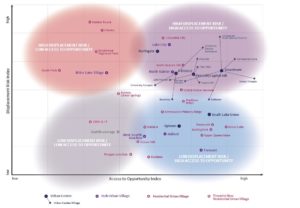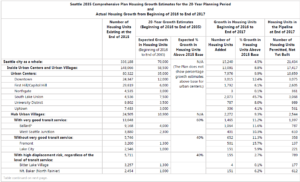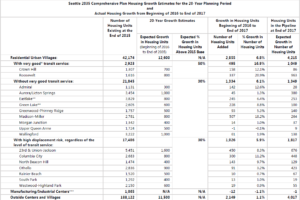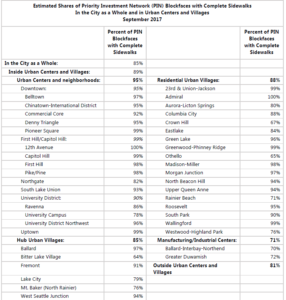Prepaid Postage for Returned Ballots; In-District Office Hours and Special Guest CM González!; Office of Planning and Community Development Growth Monitoring Report- D1 Highlights; Duwamish Valley Affordable Housing Coalition Wins Economic Development Initiative Award; Motor vehicle exhaust noise law goes into effect July 22; SW Precinct offering free use of engraver; Wrong Streetcars Purchased for Center City Streetcar
Prepaid Postage for Returned Ballots

As you may have heard, last May the King County Council approved the King County Elections request for prepaid postage for every voter in the County so that they could return their ballot through the mail without a stamp.
King County Elections conducted two prepaid postage pilots last year. By eliminating the need for a stamp, it removes a barrier for voters, encourages higher return rates, and allows communities to become more engaged in elections.
Additionally, 21 ballot drop boxes will remain across the City of Seattle where you can return your ballot 24/7 and up until 8 p.m. on election day. Remember if you return your ballot via mail they need to be postmarked by election day. If you’re returning your ballot on election day the drop boxes are the best option to ensure that your vote is counted.
In-District Office Hours and Special Guest CM González!
On July 27, I will be at the Southwest Neighborhood Service Center (2801 SW Thistle St) from 2:00 p.m. – 6:45 p.m. Please be sure to arrive no later than 6:30 p.m., the final meeting of the day will begin at 6:30 p.m.
Councilmember González will be joining me between 2 p.m. and 3:30 p.m.
These hours are walk-in friendly, but if you fwould like to let me know you’re coming in advance you can email my scheduler Alex Clardy (alex.clardy@seattle.gov).
Additionally, here is a list of my tentatively scheduled office hours. These are subject to change.
Friday, September 21, 2018
South Park Community Center, 8319 8th Avenue S
Friday, October 26, 2018
Southwest Neighborhood Service Center, 2801 SW Thistle St
Friday, December 14, 2018
South Park Community Center, 8319 8th Avenue S
Office of Planning and Community Development Growth Monitoring Report- D1 Highlights
Last month the Office of Planning and Community Development (OPCD) released the Comprehensive Plan Urban Village Indicators Monitoring Report. Adopted in 2016, Seattle 2035 is Seattle’s current 20-year Compressive plan. This report is the first in a series of monitoring reports tracking the growth of Seattle through 2035. This monitoring is an important part of maintaining the transparency and effectiveness of the Comprehensive Plan. The report is broken into 3 sections; Housing and Employment Growth, Affordability and Livability.
Housing and Employment Growth
According to the report, “Seattle’s Growth Strategy directs 84 percent of housing growth to urban centers and urban villages.” District 1 contains 5 urban villages; Admiral, West Seattle Junction, Morgan Junction, South Park and Westwoord-Highland Park. The City’s Growth and Equity Analysis identifies urban villages where there is a high risk of displacement for current residents. You can see the displacement risk chart below.


The report notes Seattle’s extremely fast paced housing growth noting that, if the 21,500 housing units permitted as of December 2017 are
built, the City will have reached 52% of its 20-year housing growth estimate in just a few short years. These rates of development varied greatly among individual urban villages with high displacement. Among a notable exception to the growth rate is South Park and the Westwood-Highland Park Urban Village which had housing growth of 1% or less between the beginning of 2016 and the end of 2017.
Below you can find the full chart of the 20 year Comprehensive Plan housing growth estimates, along with actual housing growth thus far in the monitoring period for each urban center, hub urban village, and residential urban village in the city:


Sixty-nine percent of the City’s employment growth between March 2015 and March 2016 occurred in urban centers. Almost all urban centers have seen a growth in employment with one notable exception; the number of jobs in the Duwamish and Ballard-Interbay-Northend manufacturing/industrial centers declined during the same period. The Greater Duwamish M/IC lost roughly 600 jobs during the monitoring period.
The first year of the monitoring, between March 2015 and March 2016 saw varies rate of growth in Seattle’s six urban hub villages. Among the areas that grew more rapidly was the West Seattle Junction where employment grew by 9%.
Affordability
Seattle 2035’s goal is to achieve a supply of housing that is diverse and affordable. The monitoring report acknowledges that “Seattle’s high housing costs are making it increasingly difficult for low-income household to live in our city.” The Comp Plan found that meeting the plan’s 20-year growth estimate of 70,000 net new housing units would require roughly 27,500-36,500 new affordable units at or below 80% area medium income (AMI). It should be noted these numbers did not account for existing unmet affordable housing needs and as such the need for new affordable housing units is likely much higher.
The affordability section of the report monitors two different indicators including affordability of market-rate rental housing and income-restricted affordable housing. The data for these indicators shows several key factors for the city as a whole:
- Market-rate apartment units in medium-to-large complexes, the most common form of rentals, are largely unaffordable to low income households
- Small apartment complexes and multiplexes are more affordable but are decreasing as a share of rental housing in the city.
- Average rents for newer properties are notably higher than those for older properties
- The affordability of market-rate apartments varies greatly from one urban center to the next
- As of March 31, 2018, the supply of income-restricted affordable housing in Seattle totaled approximately 29,370 units.
- Of the rent- and income-restricted units existing in Seattle as of March 2018, roughly 82 percent are inside urban centers and villages.
Livability
The final section of the monitoring reporting addresses livability including access to transit, presence of sidewalks, and access to parks and open space. Of these three livability indicators the report notes:
- Within the urban villages 84% of housing units are within a half mile walk of transit running every 10 min or better and 99% are within a half-mile walk of transit running every 15 minutes or more. This includes the West Seattle Junction.
- The report also notes that “Admiral is unique among urban villages in that none of the housing in this village is within a 10-minute walk of either 10-minute or 15-minute transit service. Corridors serving Admiral are identified in the Frequent Transit Network as priorities for upgrades to 15-minute service.”
- There are several urban villages in south Seattle, including Westwood-Highland Park that have low rates of sidewalk completion as part of the Pedestrian Master Plan Priority Investment Network. See figure below for more details

Duwamish Valley Affordable Housing Coalition Wins Economic Development Initiative Award
Earlier this month it was announced by the Office of Planning and Community Development that the Duwamish Valley Affordable Housing Coalition was given an Economic Development Initative (EDI) award of $75,000 to build the capacity of the Coalition and the South Park community. The coalition intends to use the money to explore anti-displacement strategies that ultimately result in a community-serving project that includes affordable housing, childcare and community space.
While the DVAHC is still growing, the founding members include The Duwamish River CleanUp Coalition, Puentes Advocacy, Counseling & Education (Nuestro Barrio), South Park Information and Resource Center, and South Park Neighbors Association. Congratulations to the Duwamish Valley Affordable Housing Coalition!
Motor Vehicle Exhaust Noise Law Goes into Effect July 22
The motor vehicle exhaust noise law adopted by the Council last month goes in to effect on July 22nd.
SPD has indicated they will begin with warnings before issuing citations.
SW Precinct Offering Free Use of Engraver
The Southwest Precinct is making a professional engraver available for use, free of change.
The engraver allows you to mark your property with an identifying number. These markings assist the Seattle Police Department in getting recovered property back to victims, as well as aid with investigations.
If you are interested in renting an engraver- please stop by the SW Precinct (2300 SW Webster St.) and speak with the desk officer.
Thanks to SW Crime Prevention Coordinator Jennifer Danner for this information. SPD also encourages residents to use a household inventory sheet, to fill out and keep in a safe place. The SW Crime Prevention Coordinator also offers free residential and commercial safety/security assessments. You can contact her at jennifer.danner@seattle.gov.
Wrong Streetcars Purchased for Center City Streetcar
While we are awaiting the results of the independent review of the Center City Streetcar ordered by the Mayor a media report noted that the new streetcars as designed won’t fit in the existing maintenance barns, and that there may be an issue of whether they fit the gauge of rail.
Council Central Staff, on my request, has verified the accuracy of this report; it appears the error will require either a change order for the design of the streetcars or incur new costs for construction of new or retrofitted maintenance barns. I am requesting that the Mayor’s Streetcar Assessment include full transparency in the added costs for this unfortunate error.
It’s disappointing to hear this—these issues of accountability need to be dealt with much earlier, and they highlight the need for the increased Capital Project Oversight the Council has been working on.
Posted: July 20th, 2018 under Councilmember Herbold, Office of Police Accountability, Parks and Recreation, Police Department
Tags: affordability, Center City Streetcar, housing and employment growth, King County Elections, livability, motor vehicle exhaust noise law, parks, Prepaid Postage for Returned Ballots, sidewalks, Southwest Precinct professional engraver, transit


Pingback from Morning Crank: Another Interim Head for SDOT, More Streetcar Fallout, A Victory for Burke-Gilman Trail Advocates, and "Tolling to Make Congestion Worse." | The C Is for crank
Time July 25, 2018 at 7:23 am
[…] City Connector” yesterday that confirmed some of what city council member Lisa Herbold was talking about a full five days ago (when I was on vacation; sorry!): The vehicles the city ordered for the […]